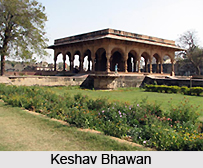 The Jat rulers of Bharatpur treated Deeg as their summer resort. Rulers, such as, Suraj Mai contributed immensely in beautifying the region by building palace and fort. The Deeg palace stands even today as witness to the by-gone eras. There are several bhawans inside this palace and one of them is the Keshav Bhawan.
The Jat rulers of Bharatpur treated Deeg as their summer resort. Rulers, such as, Suraj Mai contributed immensely in beautifying the region by building palace and fort. The Deeg palace stands even today as witness to the by-gone eras. There are several bhawans inside this palace and one of them is the Keshav Bhawan.
Keshav Bhawan is an open pavilion and is pleasantly situated with Rup Sagar on one hand and the garden on the other. It is an open pavilion and the building is placed on a platform projecting semi-octagonal quoins recalling the pattern of the bases of towers of Mughal structures.
The baradari or the Keshav Bhawan occupies a noticeable position over the artificial lake of Deeg Palace, of which a portion seems to have been utilised by the designers for constructing this structure. It is a single storeyed building with moderate height. Each face of the building is composed of five noble arches which served as vertical passages for light. The most fascinating factor of the building lies in the interior planning, some of which were intended to generate a thrilling panorama of the rainy season.
In the centre, the Bhawan is divided by an arcade running on all sides and forming an inner square which is separated from the outer one by means of a wide canal. The canal is bounded on both of its ends by tiny jets and has a bolder row of larger fountains in the middle. Keshav Bhawan unlike the other buildings is not stressed outwardly but bears a double roof which was once used for featuring the artificial thunder of clouds. It set the spectacle of rain, and the fountains, and completed the picture by producing a rainbow in a sunny day.
This article is a stub. You can enrich by adding more information to it. Send your Write Up to content@indianetzone.com



















